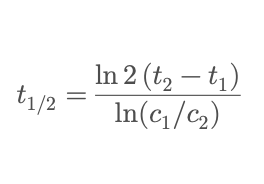Maxi
#22
Thank you. What dou you mean “an artifact of tissue uptake of rapamycin that reduces blood levels” , I have trouble understanding
Maxi
#23
Here is what I measured. The first graph is C (ug/l) after ingestion (14mg, no GPJ), the second C (in % of Peak) after Peak Time (several measurements). This checks with what you are saying, but for me hard to understand why this does not represent the usual metabolization and hence half tim. Could you please point me to more information (studies ?) . At 48 hrs I am at percentages of Peak, i.e. in the order of 1 ug/l. How can you measure for additional 48 hrs ? Or does C rise again ? Am I wrong ? Thank you for clarifying.
Pik 3 Curves 14 mg Feb March 2025.pdf (90.1 KB)
Sirolimus Half.Time Exp 15 03 2025.pdf (74.8 KB)
Yes  Your model is visibly totally off:
Your model is visibly totally off:
what are the concentrations and time for those green points?
Maxi
#25
You are probably right. I’ll take more points downstream.
Just use the last 2 points to compute the half-life.

1 Like
59vw
#27
Agree with cl-user, just use the last two points and maybe a 72 hour point to compute the half life. The early blood concentrations are not showing steady state kinetics and will throw the entire model off. After about 48 hours you will be in steady state kinetics and several time points applied to the equations above will give you the T 1/2.
I have not really tried to get into this, but superficially a dimensional analysis gives ln time, not time which confuses me.
cl-user
#29
The formula I pasted is poorly formatted. It’s ln(2) * (t2 - t1) / ln(c1/c2) which gives the half life in the same unit as t2 and t1.
OK that’s dimensionally correct. I have not engaged brain to work out whether I agree with the formula or not,
I take 7mg/week Rapacan. No explicit boosters, but not on an empty stomach.
55kg
72yo
Tested 3.5 ng/ml at approximately 48 hours, 1.8 ng/ml at 96 hours. Pretty easy to eyeball that and say half life of 50 or so hours.
Anyway, I fed the numbers into 4o and also mentioned that a couple of years ago, I measured 48 ng/ml two hours after taking 10mg. It calculated a proportionate level of around 33 ng/ml as an estimated max level for 7mg.
The results follow:
Sirolimus_PK_Model_With_Formula.pdf (25.6 KB)
3 Likes
59vw
#32
Yep this is a good way to measure T1/2. Complete with a graph showing the change from absorption to steady state kinetics and why you need to wait until 48 hours or later to take your two measurements to calculate half life. Thanks for the detail!